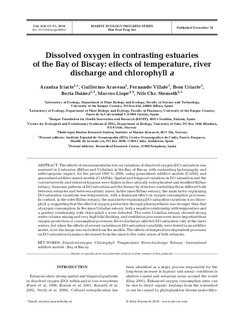Dissolved oxygen in contrasting estuaries of the Bay of Biscay: effects of temperature, river discharge and chlorophyll a
Iriarte, Arantza; Aravena, Guillermo; Villate, Fernando; Uriarte, Ibon; Ibáñez, Berta; Llope, Marcos; Stenseth, Nils Christian
Journal article, Peer reviewed
Permanent lenke
http://hdl.handle.net/11250/109165Utgivelsesdato
2010-11-18Metadata
Vis full innførselSamlinger
- Articles [3040]
Originalversjon
http://dx.doi.org/10.3354/meps08812Sammendrag
The effects of environmental factors on variations of dissolved oxygen (DO) saturation was
assessed in 2 estuaries (Bilbao and Urdaibai) in the Bay of Biscay with contrasting hydrography and
anthropogenic impact, for the period 1997 to 2006, using generalised additive models (GAMs) and
generalised additive mixed models (GAMMs). Spatial and temporal variations in DO saturation and the
current severity and extent of hypoxia were higher in the culturally eutrophicated and stratified Bilbao
estuary. Seasonal patterns of DO saturation and the hierarchy of factors controlling them differed both
between estuaries and between salinity zones. In the inner Bilbao estuary, the main factor explaining
DO-saturation variations was temperature, with a dominant effect on oxygen consumption processes.
In contrast, in the outer Bilbao estuary, the main factor explaining DO-saturation variations was chlorophyll
a, suggesting that the effect of oxygen production through photosynthesis was stronger than that
of oxygen consumption. In the inner Urdaibai estuary, both a negative relationship with temperature and
a positive relationship with chlorophyll a were detected. The outer Urdaibai estuary showed strong
water-column mixing and very high tidal flushing, and ventilation processes were more important than
oxygen production or consumption processes. River discharge affected DO saturation only at the inner
waters, but when the effects of several variables on DO-saturation variability were tested in an additive
model, river discharge was excluded from the models. The effects of temperature-dependent processes
on DO-saturation dynamics decreased from the inner to the outer zones of both estuaries.
